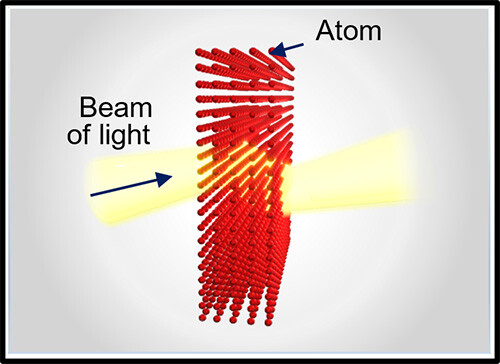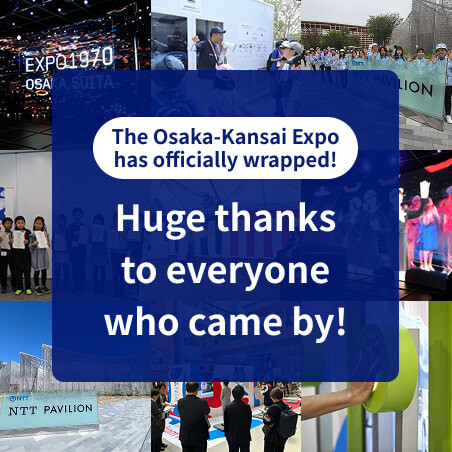Microsoft ends support for Internet Explorer on June 16, 2022.
We recommend using one of the browsers listed below.
- Microsoft Edge(Latest version)
- Mozilla Firefox(Latest version)
- Google Chrome(Latest version)
- Apple Safari(Latest version)
Please contact your browser provider for download and installation instructions.
February 13, 2025
NTT Corporation
Lancaster University
A New Meta: Realizing Negative Refraction of Light Using Atomic Media
A novel platform towards applications such as powerful lenses and cloaking devices
 A Beam of Light Undergoing Negative Refraction Within a Lattice of Laser-Trapped Atoms
A Beam of Light Undergoing Negative Refraction Within a Lattice of Laser-Trapped Atoms
Highlights:
- Researchers at NTT and Lancaster University have demonstrated with theory that negative refraction of light is possible in cooperatively responding atoms, trapped in a lattice using lasers.
- Atomic lattices offer an alternative platform to conventional metamaterials, where achieving negative refraction of light is hindered by material dissipation and fabrication imperfections.
- This work paves new paths toward transformative applications, including optical cloaks and superlenses, of negative refraction.
Researchers at NTT and Lancaster University have established large-scale microscopic simulations to reveal that that cooperatively responding atoms, ordered in a lattice, can achieve negative refraction—a phenomenon with the potential for powerful technologies such as cloaking and superlenses that focus light beyond the diffraction limit. Artificially fabricated structures, called metamaterials, have conventionally been used to demonstrate the negative reflection of light. However, they suffer from limitations of material absorption and fabrication imperfections at optical frequencies. Our approach, based on precisely structured and readily tunable atomic lattices, is free from absorption losses and offers unprecedented control over light-matter interactions, paving the way for near-term exploration and development of negative refraction's transformative potential.
Background:
Refraction —the familiar bending of light at the boundary between different materials—is a common phenomenon. Negative refraction, however, is the curious case where light bends in the opposite direction (Fig.1) to what is typically seen in nature. This unusual effect has been a major driver of decades of research due to its potential in groundbreaking applications, such as superlenses that focus light beyond the diffraction limit and cloaking devices that can render objects invisible.
Metamaterials—artificially fabricated structures—have been a central approach in efforts to overcome the limitations of natural materials and achieve negative refraction. These materials typically use resonators [1] that are designed to interact with both the electric and magnetic fields present in light. When carefully constructed and arranged at the nanoscale, their combined emission causes the light to bend backwards. Despite progress in conventional metamaterials, however, negative refraction and its practical applications have remained constrained at optical frequencies due to dissipation of light and fabrication imperfections.
Results of Our Work:
Now, researchers at NTT and the University of Lancaster have theoretically demonstrated that negative refraction of light can be achieved using cooperatively responding atoms, arranged in a lattice (Fig. 2), which eliminates a reliance on conventional metamaterials. These precisely arranged atomic crystals offer exceptional control over the interactions between light and matter, providing a pristine, clean medium free from absorption losses and fabrication imperfections. This unique combination of properties makes atomic lattices a promising alternative to metamaterials for exploring and developing applications, such as optical cloaks and superlenses, of negative refraction.
Details:
This new approach uses laser-trapped atoms that, in state-of-the-art experiments, can be arranged to form a perfectly ordered "crystal". Here,each atom acts as an oscillating electric dipole [2] capable of both emitting and absorbing radiation. Closely spaced atoms strongly interact with one another through the light they radiate, and these interactions give rise to a collective optical response that cannot be predicted by considering atoms in isolation. By tuning the lattice and the incident beam, negative refraction of light can be achieved in the cumulative radiation of these interacting atoms.
To theoretically demonstrate this, researchers established large-scale simulations that precisely predict how atoms respond to laser light, including how they are excited and how they emit radiation. These are made possible by a detailed microscopic description of the atomic medium that accurately captures all light-induced atom-atom interactions. Using these simulations, researchers analyzed the propagation of a beam of light within the atomic medium and observed its negative refraction across a wide range of beam and lattice configurations, with two specific cases of five layers and twenty-five layers shown in Fig. 3. In short, negative refraction can be achieved and studied in a controlled and variable setting.
Outlook:
This approach leverages near-term advancements in atomic lattice capabilities, offering a path forward for exploring and developing technologies based on negative refraction such as superlenses and optical cloaks. Atomic lattices further offer a powerful platform for both deepening our understanding of optics and expanding possibilities beyond the current metamaterial paradigm. Featuring strong interactions and single-photon nonlinearities [3], they could excel as tools for quantum simulations and interfaces, with implications even for quantum information processing technologies.
Journal Information:
Journal: Nature Communications
Title: Negative refraction of light in an atomic medium
Authors: Lewis Ruks (NTT Basic Research Laboratories); Kyle Ballantine, and Janne Ruostekoski (Lancaster University)
DOI: 10.1038/s41467-025-56250-w
URL: https://www.nature.com/articles/s41467-025-56250-w
Technical Language:
[1]Resonator: a structure that confines light by repeatedly reflecting it internally, creating specific patterns. Two parallel mirrors are a basic example.
[2]Oscillating electric dipole: The periodic motion of positive and negative charge, which creates a changing electromagnetic field. In atoms, this is realized in the electron cloud shifting relative to the nucleus.
[3]Single-photon nonlinearity: A quantum effect where the presence of a photon changes how an atom interacts with additional light, mediating an interaction between two photons that would not normally interact.
Figures:
 Figure 1: What is Negative Refraction?
Figure 1: What is Negative Refraction?
(Left) Refraction of light at the interface of a medium (grey box). Positive refraction (green) bends the beam within the upper region (above the dashed line), while negative refraction (red) bends it in the opposite direction. (Right) In a negatively refracting medium (grey box), light rays coming from a fish could bend at the interface with air (red lines) to refocus into the eyes of the cat on the left, or to be directed away and hide the fish from the cat on the right. For comparison, a usual case of refraction is shown in the faint green lines. This simple difference entails powerful applications such as superlenses and cloaks for light.
 Figure 2: Realizing Negative Refraction of Light Using an Atomic Medium
Figure 2: Realizing Negative Refraction of Light Using an Atomic Medium
(Left) Lasers are used to create a periodic pattern of light, which confines atoms to form a structured lattice. (Middle) Under illumination, closely spaced atoms interact strongly through dipole emission and absorption of light, producing a collective response. (Right) The emission of these interacting atoms results in a negative refraction of light within the atomic lattice.
 Figure 3: Simulations Reveal Negative Refraction of Light in an Atomic Medium
Figure 3: Simulations Reveal Negative Refraction of Light in an Atomic Medium
(Left) Simulation of a beam passing through a 5-layer cubic atomic lattice, where each layer contains 625 atoms. The green dots represent individual atoms, with separations on the order of hundreds of nanometers. Negative refraction causes the outgoing beam to shift downwards. (Right) Simulation of negative refraction in a larger lattice, with twenty-five layers, reveals how the beam is deflected upon entering and exiting the atomic medium (bounded by the dashed green box).
About NTT
NTT contributes to a sustainable society through the power of innovation. We are a leading global technology company providing services to consumers and business as a mobile operator, infrastructure, networks, applications, and consulting provider. Our offerings include digital business consulting, managed application services, workplace and cloud solutions, data center and edge computing, all supported by our deep global industry expertise. We are over $97B in revenue and 330,000 employees, with $3.6B in annual R&D investments. Our operations span across 80+ countries and regions, allowing us to serve clients in over 190 of them. We serve over 75% of Fortune Global 100 companies, thousands of other enterprise and government clients and millions of consumers.
Media contact
NTT Science and Core Technology Laboratory Group
Public Relations
Inquiry form
Information is current as of the date of issue of the individual press release.
Please be advised that information may be outdated after that point.
NTT STORY
WEB media that thinks about the future with NTT










